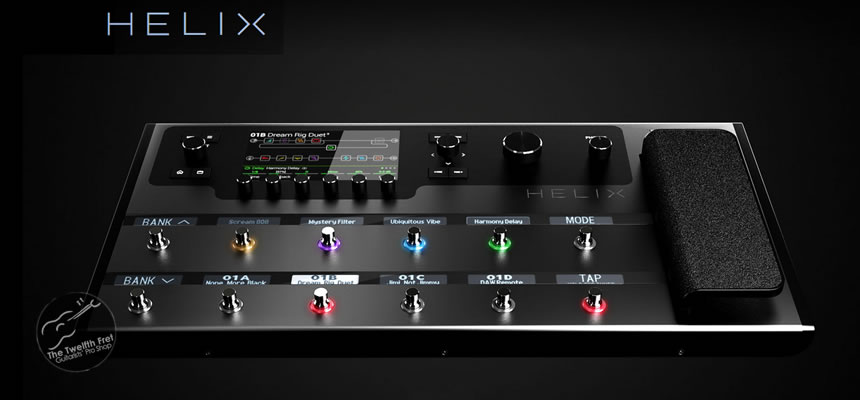
Line 6 Helix Guitar Multi-Effects Processor
The world of guitar amp modeling has come a long way in recent years. Take a look at the gear being used by active, touring guitar players all around the world and you’ll notice a common trend; “real” amps are steadily being augmented or replaced by a variety digital amp modeling units. Units like the Axe-FX II by Fractal Audio Systems or the Kemper Profiler have become the backbone of countless guitar rigs.
As pioneers of the amp-modeling world, Line 6 Helix guitar multi-effects processor jumped back on to the pro-level stage with Helix; an all-in-one amp + cabinet modeler and effects processor. Make no mistake… this is not just another Pod. By utilizing component-level modeling, the amp models in Helix are dynamic, expressive, and nuanced in all the same ways as their tube-powered counterparts. A huge selection of speaker cabinets, as well as the ability to load your favorite cabinet impulse responses, means you can quickly and easily assemble the guitar rig of your dreams. As always, Line 6 has provided a fantastic selection of studio-grade effects to play with.

Line 6 Helix Guitar Multi-Effects Processor
As someone who has always loved the idea of getting every guitar tone I need from a single box, but has never been satisfied with the tone of previous amp modelers, I decided to take a Line 6 Helix guitar multi-effects processor home with me and get to know it a little better. The first thing that impressed me was just how easy to use it is. The large, colored display screen gives you a perfect view of your signal chain at all times, while the joystick and control knobs make the task of selecting blocks and editing perimeters quick and intuitive. The “drag and drop” process of adding or moving amps, cabinets, or pedals around within your signal chain lets you make routing changes in seconds. While being quick and easy to use is a great feature in its own right, it is the feeling of “experimentation” that I found truly compelling. With my entire signal path laid out in front of me, I found myself toying with tonal possibilities out of simple curiosity as much as anything else. “I wonder how this delay pedal would sound if I put it after the speaker cabinet?”, or “what if I run these 2 pedals parallel instead of in series?”. No longer tied down to the real-world constraints of managing cables, power supplies, volume levels, or floor space, I was free to experiment with my guitar tones in ways that are not practical or even possible using “real” gear.
That’s all well and good, but none of that really matters if the tones coming out of the Helix aren’t as good as the tones I get out of an AC30 or a Deluxe Reverb or a JCM800, right? Let me just say this; after spending a week with the Helix Line, I ditched every other piece of guitar gear that I own. Amps, pedals… all gone. I just don’t need them anymore. Not only does the amp modeling in the Helix sound great, but in many situations it can sound better than a tube amp because you are not tied to the same restrictions as a “real” amp. I don’t need to run the Helix at a certain volume to get the tone I want, I don’t need to worry about having the ideal speaker cabinet for the particular tone I am trying to create. Plus there is the unquestionable benefit of being able to run your guitar signal directly into your recording setup, or your studio monitors, or into the PA at a gig. The guitar tones I’m recording with Helix in my home studio are better than any tones I was able to get with a mic in front of my AC30, because I don’t need to worry about the usual noise issues or volume constraints.
Long story short, the Line 6 Helix won me over. Units like this certainly won’t be for everyone. Some people will always prefer the simplicity of a single amp and a few pedals on the floor in front of them. A processor as deep and expansive as the Helix takes a little time to get to know. You’ll need to experiment a little bit to figure out how to best work it into you setup. Are you using it as an all-in-one tone creation machine? Are you using it as an effects processor and pairing it with a physical amp? Are you playing through headphones, or powered speakers, or a guitar cabinet? All of these scenarios require some tinkering to get the best tones possible… but they are all possible with the Helix, which is the real take away, I think.
Here’s a great demo video by Pete Thorn, featuring the Helix. Rather than the usual feature-by-feature review, he’s recorded a track while using the Helix in a variety of different setups, highlighting each configuration so you can get an idea of the various ways to work the Helix into your guitar rig, while also hearing how it sounds.
The Line 6 Helix is now in-stock here at the Twelfth Fret, for the price of $1999.
– Nevin Douglas, Twelfth Fret Guitar Shop
